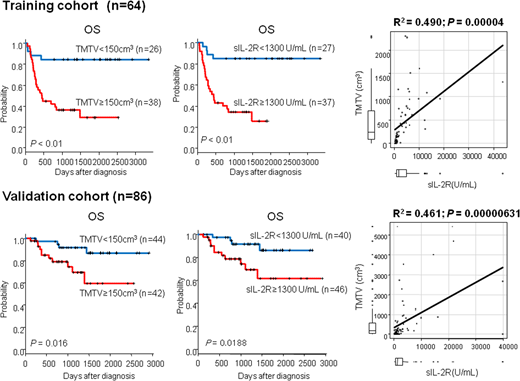Abstract
Background. Diffuse large B-cell lymphoma (DLBCL) is the most frequent subtype of non-Hodgkin lymphoma. High total metabolic tumor volume (TMTV) or total lesion glycolysis (TLG) calculated using 18F-FDG PET/CT images at diagnosis predicts poor prognosis of patients with DLBCL. However, high cost and poor access to the imaging facilities hamper wider use of 18F-FDG PET/CT.
Methods. In order to explore a surrogate marker for TMTV/TLG, we evaluated the correlations between the serum levels of soluble interleukin-2 receptor (sIL-2R) and TMTV/TLG in 64 patients with DLBCL, and the results were verified in an independent validation cohort of 86 patients. The study procedures were in accordance with the Helsinki Declaration and institutional ethical guidelines, conducted under the auspices of the institutional ethics committee, and approved by the institutional review boards.
Results. In the training cohort(n=64), OS and EFS were significantly lower in patients with TMTV≥150cm3 than in those with less than 150cm3 [5-year OS; 84.0% vs 29.1%, P=0.000194, 5-year EFS; 71.4% vs 28.7%, P=0.000384]. We also found that TLG≥1500cm3 at diagnosis predicted significantly inferior OS and EFS[5-year OS; 84.0% vs 31.7%; P=0.000477, 5-year EFS; 70.2% vs 30.6%, P=0.00107].Pearson's correlation tests demonstrated highly significant positive correlations between sIL-2R and TMTV[R2=0.490; P=0.00004] and between sIL-2R and TLG[R2=0.543; P=0.00000357]. Serum sIL-2R≥1300 U/ml was a strong prognostic factor both for worse OS and EFS[5-year OS; 85.2% vs 25.9%, P=0.000035, 5-year EFS; 72.0% vs 26.8%, P=0.000076].In a univariate analysis, B symptom, LDH, sIL-2R, TMTV and TLG were associated with poor 5-year OS; and B symptom, LDH, PS, sIL-2R, TMTV and TLG were identified as poor prognostic factors for 5-year EFS. We performed multivariate analysis that included sIL-2R and all factors in NCCN-IPI; age, LDH, clinical stage, ECOG PS and major organ involvement. In this multivariate analysis, age and sIL-2R were independently associated with poor 5-year OS(age; HR, 4.44; 95% CI, 1.05 to 18.7, P=0.0424, sIL-2R; HR, 4.45; 95% CI, 1.04 to 19.1, P=0.0444). Another multivariate analysis that included TMTV and all factors for NCCN-IPI demonstrated that TMTV was an only independent prognostic factor for 5-year OS(HR, 3.87; 95% CI, 1.08 to 13.8; log-rank, P=0.0373).Subgroup analyses included the patients with NCCN-IPI High-Int and High(n=49) demonstrated that the cut off value of TMTV 150cm3 stratified treatment outcomes in this poor prognostic group [5-year OS; 75.0% vs 27.7%, P=0.0355, 5-year EFS; 66.7% vs 29.7%, P=0.0493]. Similar results were obtained using the cut-off value of sIL-2R 1300U/mL [5-year OS; 75.0% vs 25.9%, P=0.0182, 5-year EFS; 58.3% vs 29.7%, P=0.0499].
In the validation cohort(n=86), Kaplan-Meier curves showed that OS and EFS in patients with TMTV≥150cm3 was again lower than in those with TMTV<150cm3[5-year OS; 87.0% vs 59.5%, P=0.016, 5-year EFS; 72.8% vs 52.3%, P=0.0154]. We also found that TLG≥1500 cm3 at diagnosis predicted inferior OS and EFS as TMTV did[5-year OS; 84.8% vs 59.3%, P=0.0157; log-rank, 5-year EFS; 74.8% vs 45.8%, P=0.000604]. Kaplan-Meier curves showed that sIL-2R≥1300 U/ml was a strong prognostic factor both for worse OS and EFS[5-year OS; 86.3% vs 61.8%, P=0.0188, 5-year EFS; 85.0% vs 46.8%, P=0.000413]. Pearson's correlation tests gave similar results that there were positive correlations between sIL-2R and TMTV [R2=0.461; P=0.00000631], and between sIL-2R and TLG[R2=0.720; P=0.0000017987]. In a univariate analysis, TMTV and TLG were associated with poor 5-year OS, whereas sIL-2R, TMTV and TLG were identified as poor prognostic factors for EFS. In a multivariate analysis including sIL-2R, age and sIL-2R were associated with poor 5-year OS. In another multivariate analysis including TMTV showed that age, LDH and TMTV were independent prognostic factor for 5-year OS. Altogether, we could validate the prognostic significances of sIL-2R, TMTV, and TLG, and positive correlation between sIL-2R and metabolic values, such as TMTV and TLG, confirming that sIL-2R is a surrogate biomarker of these metabolic values.
Conclusion. Serum level of sIL-2R represents a convenient surrogate marker to estimate metabolic tumor burden measured by 18F-FDG PET/CT that can predict treatment outcomes of patients with DLBCL.
Disclosures. No relevant conflicts of interest to declare.
Author notes
Asterisk with author names denotes non-ASH members.


This feature is available to Subscribers Only
Sign In or Create an Account Close Modal